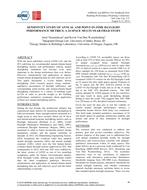Click here to purchase
Achieving a Net Zero Energy (NZE) building requires incorporating costly onsite renewable energy generation, which can be reduced with energy efficiency measures (EEMs). NREL’s Building Energy Optimization software (BEopt) automates building simulation runs to determine the cost-optimal combination of energy generation and energy efficiency for residential construction. However, several factors prevent BEopt from being an effective tool for commercial building design. This paper proposes an adaptation of the BEopt method, referred to here as the adapted Commercial Building Energy Optimization process (CBEO), to accommodate the greater complexities and demands of commercial building design.
The CBEO process begins by setting an economic performance benchmark, against which EEMs are analyzed, the cost of renewable energy generation onsite. Comparison to a fixed economic benchmark avoids the need to analyze all measures simultaneously, allowing, for instance, massing to be optimized earlier than mechanical equipment. Later in design, EEMs are bundled to capture synergies that reduce capital cost and increase energy efficiency. This paper presents the application of the CBEO process to the Archbold Biological Station Lodge and Learning Center. In this project, significant cost savings were achieved. For instance, highly effective daylighting eliminated the need for dimmable electric lighting and daylight sensors in most spaces because design light levels were achieved with daylight alone. As shown in the case study, the adapted process has some limitations in comparison to the BEopt software including decreased automation and loss of the ability to accurately identify optimal packages of EEMs at lower efficiency targets (such as 20 percent below an energy code).
Citation: ASHRAE Conference Papers, Las Vegas, NV
Product Details
- Published:
- 2011
- Number of Pages:
- 8
- File Size:
- 1 file , 530 KB
- Product Code(s):
- D-LV-11-C038


